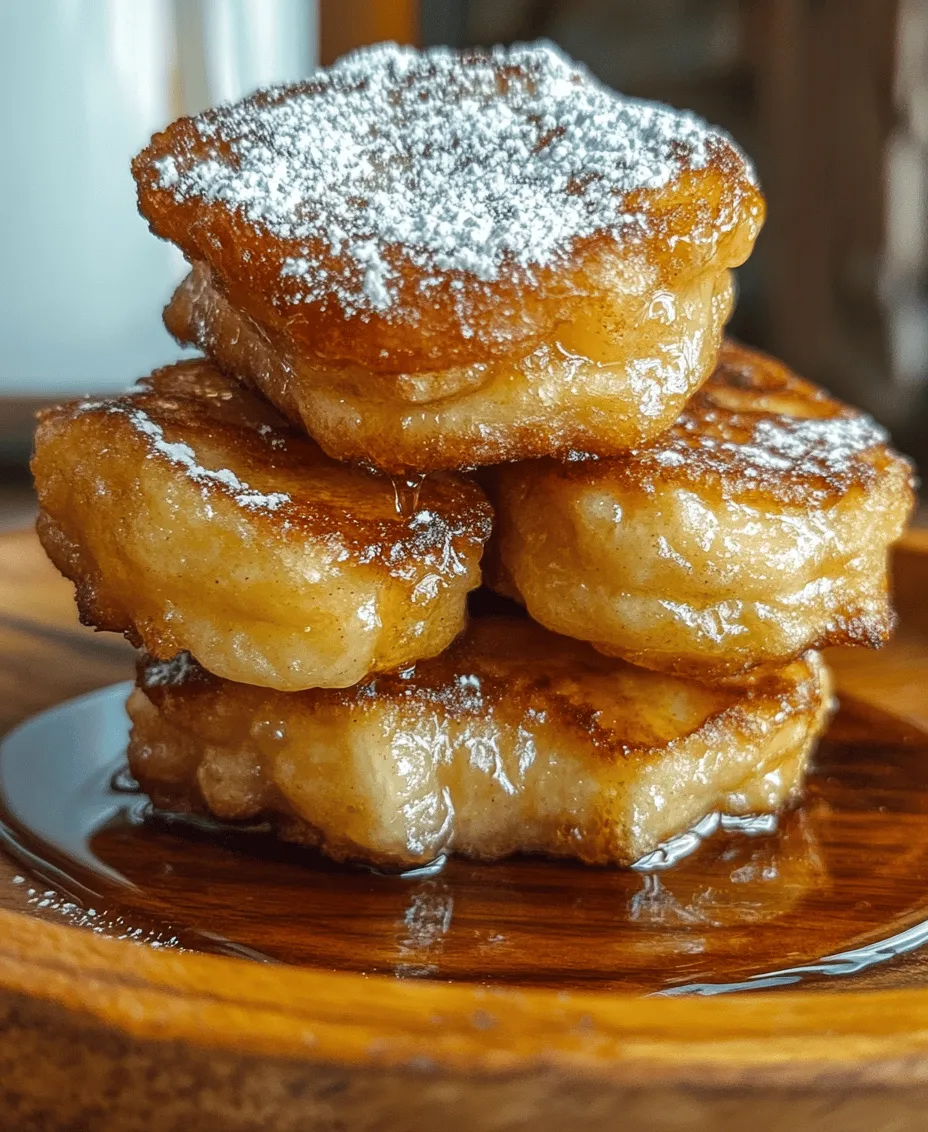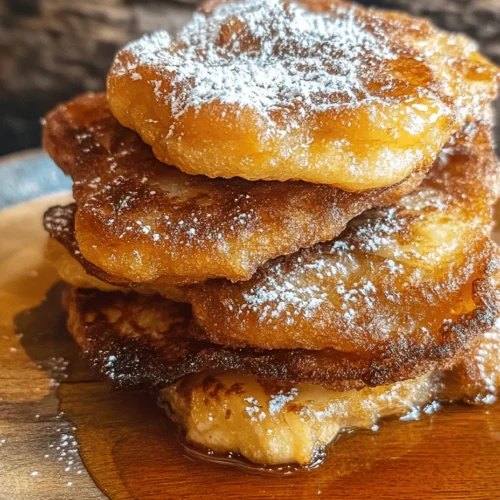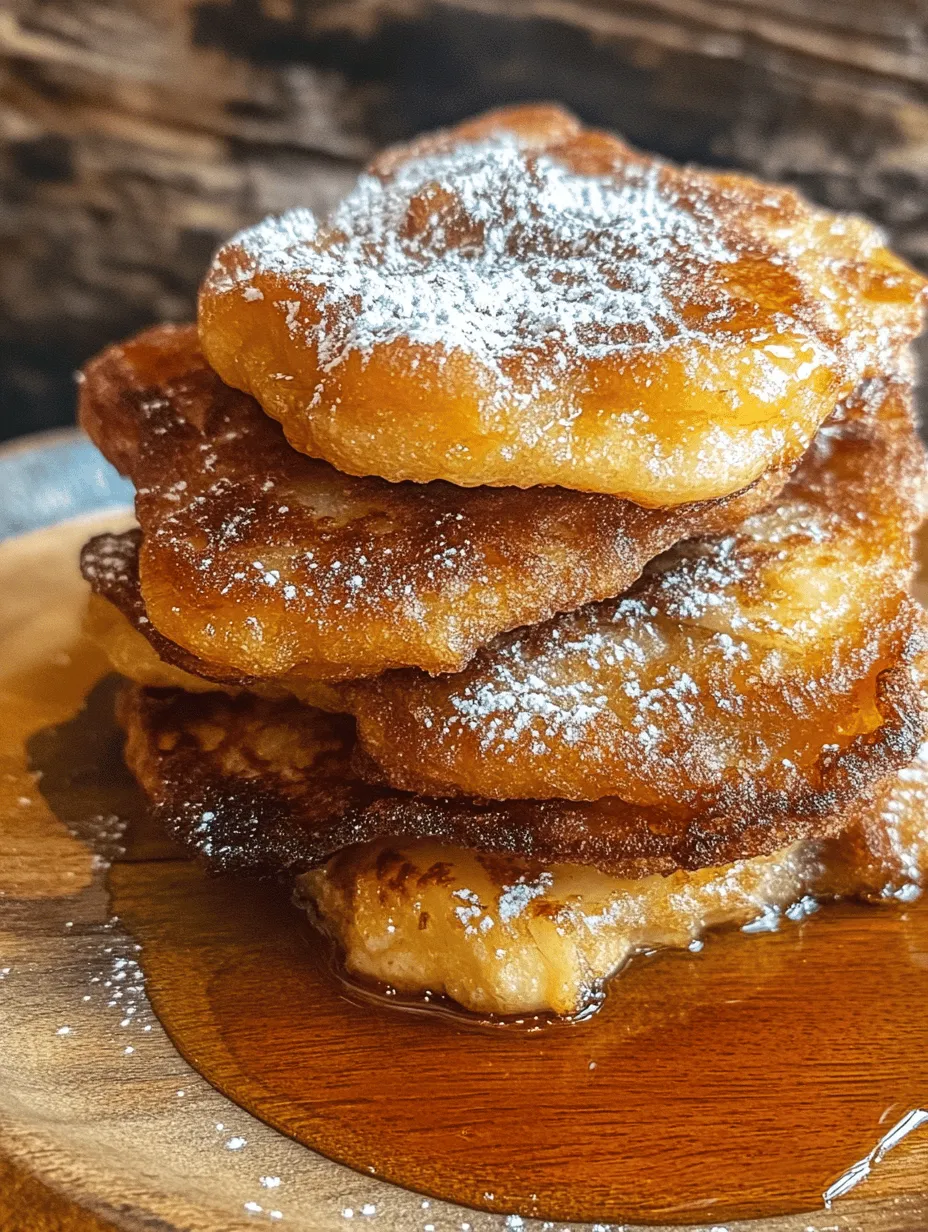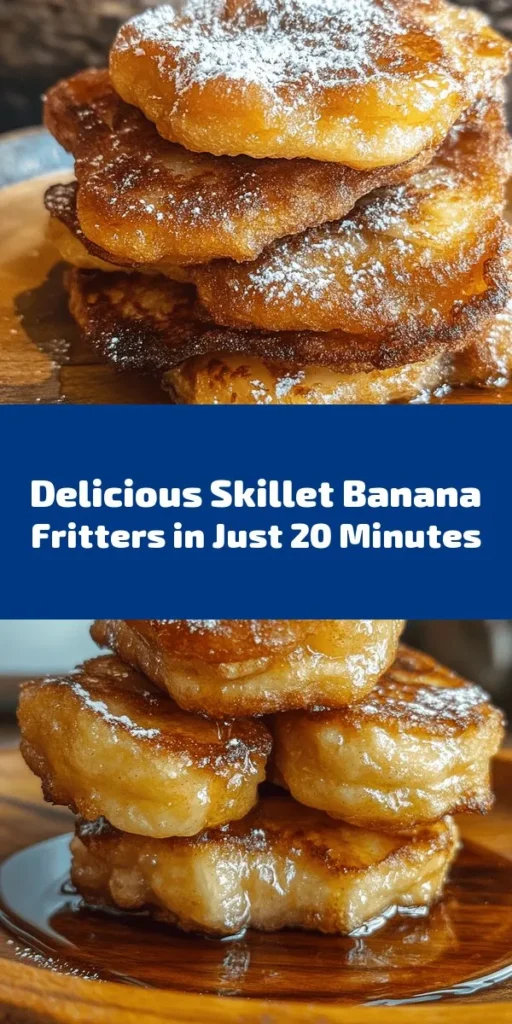Introduction
Banana fritters are a delightful treat that brings together the natural sweetness of ripe bananas with a crispy, golden-brown exterior. This dish is not just limited to dessert; it can also serve as a delicious breakfast or a satisfying snack at any time of the day. The beauty of banana fritters lies in their simplicity and versatility, making them a favorite for both novice cooks and seasoned chefs.
In this article, we will explore the fascinating world of skillet banana fritters, covering everything from their ingredients and preparation methods to variations and serving suggestions. By the end of this guide, you’ll be well-equipped to create these mouthwatering fritters in your own kitchen.
Understanding the Ingredients
A successful batch of skillet banana fritters hinges on selecting the right ingredients. Each component plays a crucial role in achieving the perfect texture and flavor. Let’s explore the key ingredients and their significance in this delightful recipe.
The Role of Bananas
When it comes to banana fritters, the type and ripeness of the bananas you use are paramount to the dish’s success.
Importance of Ripeness: Why Overripe Bananas Are Preferred
Overripe bananas, characterized by their brown spots and soft texture, are the ideal choice for this recipe. As bananas ripen, their starches convert to sugars, resulting in a sweeter and more flavorful product. The sweetness of overripe bananas not only enhances the flavor of the fritters but also reduces the need for excessive added sugar.
Flavor and Texture Contributions of Bananas
In addition to their sweetness, overripe bananas contribute a creamy texture that helps bind the fritters together. When mashed, they create a natural moisture that complements the dry ingredients, ensuring that your fritters remain soft and fluffy on the inside while achieving that coveted crispy exterior during frying.
Essential Dry Ingredients
While bananas are the star of the show, the dry ingredients you select are equally important in crafting the perfect fritter.
All-Purpose Flour: The Foundation for Structure
All-purpose flour serves as the primary dry ingredient in banana fritters, providing the necessary structure to hold everything together. A good balance of flour is essential; too much can lead to dense fritters, while too little can cause them to fall apart during frying.
Granulated Sugar: Balancing Sweetness and Flavor
Granulated sugar enhances the natural sweetness of the bananas while also contributing to the fritters’ golden-brown color during frying. The caramelization of sugar in hot oil adds a delightful contrast of flavors, making each bite irresistible.
Baking Powder and Baking Soda: Leavening Agents for Fluffiness
Baking powder and baking soda are crucial for achieving a light and fluffy texture in your fritters. These leavening agents create air pockets within the batter, allowing the fritters to rise and become airy rather than dense. The right balance of both is essential for optimal results.
Cinnamon and Salt: Enhancing Flavor Profiles
A pinch of salt is important for balancing sweetness and enhancing the overall flavor of the fritters. Additionally, ground cinnamon adds warmth and a hint of spice, elevating the taste experience. Together, these ingredients create a harmonious blend that complements the bananas beautifully.
Wet Ingredients Breakdown
Wet ingredients play a vital role in the batter’s consistency and moisture content. Let’s take a closer look at each component.
Eggs: Binding and Texture Enhancement
Eggs are the primary binding agent in this recipe, helping to hold the fritters together while also contributing to their richness. They provide structure and moisture, resulting in a tender and flavorful final product.
Milk: Moisture and Creaminess, with Options for Plant-Based Alternatives
Milk adds moisture and creaminess to the batter. For those who prefer a dairy-free option, almond milk, oat milk, or coconut milk can be easily substituted without sacrificing flavor or texture.
Vanilla Extract: Adding Depth to the Flavor
Vanilla extract is the secret ingredient that adds an extra layer of flavor to the fritters. Its aromatic qualities enhance the overall taste profile, making the fritters even more enticing.
Choosing the Right Oil for Frying
The oil you select for frying plays a significant role in the final outcome of your banana fritters.
Recommended Oils: Vegetable, Canola, or Coconut Oil
For frying banana fritters, it’s essential to choose an oil with a high smoke point. Vegetable oil, canola oil, and coconut oil are all excellent options. These oils can withstand high temperatures without breaking down, ensuring that your fritters fry evenly and achieve that golden-brown color.
Reasons for Oil Selection: Smoke Points and Flavor
The smoke point of an oil is the temperature at which it begins to smoke and break down. Using oil with a higher smoke point prevents the fritters from absorbing unwanted flavors and ensures they are crispy rather than greasy. Additionally, the choice of oil can subtly influence the flavor of the fritters, so select one that complements the dish well.
Step-by-Step Preparation Process
Now that we’ve covered the essential ingredients for skillet banana fritters, let’s dive into the step-by-step process of creating this delicious treat.
Mashing the Bananas
The first step in preparing your fritters is mashing the bananas. This is a crucial part of the process that sets the foundation for the entire dish.
Techniques for Achieving the Right Consistency
To achieve the perfect consistency, place the overripe bananas in a mixing bowl and use a fork or a potato masher to mash them. Aim for a smooth puree with a few small lumps for texture. If you prefer a chunkier fritter, leave some banana pieces intact. The choice of texture ultimately depends on your personal preference, but a smooth batter will yield a more uniform cooking result.
Texture Considerations: Smooth vs. Chunky
Smooth mashed bananas will create a more cohesive batter, while chunkier pieces can add delightful bursts of banana flavor in each fritter. Consider what texture you enjoy most and adjust your mashing technique accordingly.
Mixing the Dry Ingredients
With the bananas prepared, it’s time to focus on the dry ingredients. Properly incorporating these elements is vital for achieving the right flavor and texture in your fritters.
Importance of Proper Whisking to Ensure Even Distribution
In a separate bowl, combine the all-purpose flour, granulated sugar, baking powder, baking soda, ground cinnamon, and salt. Use a whisk to mix the dry ingredients thoroughly. This step is crucial as it ensures that the leavening agents are evenly distributed throughout the flour, preventing any clumping that could lead to unevenly cooked fritters.
After ensuring the dry ingredients are well mixed, it’s time to combine them with the wet ingredients in preparation for frying.

Combining Wet and Dry Ingredients
When it comes to making the perfect skillet banana fritters, the way you combine your wet and dry ingredients is crucial for achieving that tender, fluffy texture. To start, ensure your mashed bananas are fully ripe; the riper, the better, as they provide natural sweetness and moisture. In a mixing bowl, combine your dry ingredients—flour, baking powder, cinnamon, and a pinch of salt. In another bowl, whisk together the wet ingredients: the mashed bananas, milk, eggs, and a splash of vanilla extract for added flavor.
Now, the key to tender fritters lies in the folding technique. Gently add the wet mixture to the dry ingredients. Using a spatula or wooden spoon, fold the mixture together until just combined. Be cautious to avoid overmixing; a few lumps are perfectly fine. Overmixing can lead to dense fritters, so use a light hand to keep the batter airy. Aim for a batter that is cohesive but still retains a bit of texture.
Heating the Skillet Correctly
The next step in crafting perfect banana fritters is heating your skillet correctly. A cast-iron skillet or non-stick frying pan works wonderfully for this recipe. Add enough oil to cover the bottom of the skillet—about 1/4 inch deep should suffice. To test if the oil is ready for frying, drop a small dollop of batter into the oil. If it sizzles and bubbles up immediately, your oil is at the right temperature, typically around 350°F (175°C). If it doesn’t sizzle, give it a few more moments to heat up.
Maintaining the right oil temperature is essential. If the oil is too hot, the fritters will brown too quickly on the outside while remaining raw inside. Conversely, if the oil is not hot enough, the fritters will absorb too much oil and become greasy. Adjust the heat as necessary during the cooking process to keep the oil at a consistent temperature.
Cooking the Fritters to Perfection
Once your oil is ready, it’s time to cook the fritters. Using a spoon or small ice cream scoop, drop the batter into the hot oil, leaving enough space between each fritter to allow for expansion. It’s important to keep an eye on the timing and visual cues while cooking. The fritters should take about 2-3 minutes on one side before flipping. Look for a golden-brown color and small bubbles forming around the edges as signs that they’re ready to be turned.
Carefully flip the fritters using a spatula, allowing them to cook for an additional 2-3 minutes on the other side. Once both sides are beautifully golden and crispy, use a slotted spoon to remove them from the skillet and transfer them to a plate lined with paper towels to absorb any excess oil.
Draining and Serving
Draining excess oil effectively is key to ensuring your fritters remain light and not overly greasy. After frying, place the fritters on a paper towel-lined plate to soak up any residual oil. This simple step not only enhances the texture but also keeps the flavors focused on the delicious bananas and spices.
For serving, you can keep it simple or get creative. A light dusting of powdered sugar adds a touch of sweetness and presentation. You can also offer a variety of syrups on the side, such as maple syrup, honey, or caramel sauce, allowing everyone to customize their fritters to their liking.
Exploring Variations of Banana Fritters
Once you’ve mastered the classic banana fritters, consider exploring various creative twists to elevate your dish. One popular variation is adding chocolate chips to the batter for a delightful surprise of melted chocolate in every bite. Alternatively, you can incorporate chopped nuts, like walnuts or pecans, which add a satisfying crunch and rich flavor.
For a tropical twist, consider folding in shredded coconut, which pairs beautifully with the bananas. You can also experiment with spices—adding a pinch of nutmeg or cardamom can introduce a warm, aromatic flavor profile that elevates your fritters significantly.
Serving Suggestions
Banana fritters shine when paired with complementary accompaniments. For a decadent treat, serve them alongside a scoop of vanilla ice cream or dollops of Greek yogurt, which contrast beautifully with the warm fritters. Seasonal fruit toppings, such as fresh berries or caramelized apples, not only enhance the presentation but also add freshness and balance to the dish.
Consider offering a variety of toppings to create a banana fritter bar, where everyone can customize their servings with toppings like whipped cream, chopped nuts, or flavored syrups. This interactive element makes for a fun and engaging dining experience.
Healthier Alternatives
If you’re looking to make your banana fritters a bit lighter, there are several substitutions you can consider. Reducing sugar is a straightforward approach; the natural sweetness of ripe bananas often allows you to cut back on added sugars without sacrificing taste. You can also swap out some of the all-purpose flour for whole wheat flour, which increases fiber content and adds a nuttier flavor.
For those with dietary restrictions, gluten-free options are readily available. Almond flour, coconut flour, or a gluten-free all-purpose blend can replace traditional flour while still delivering a delicious fritter. Just be mindful of the differences in absorbency and texture, adjusting liquid ingredients as needed.
Cultural Significance of Fritters
Fritters have a rich cultural heritage, appearing in various forms across the globe. In many Caribbean and Latin American countries, banana fritters are a beloved street food, often enjoyed as a snack or dessert. Known as “tostones” in some regions, they are sometimes served with a spicy dipping sauce or as part of a larger meal.
In Asian culinary traditions, fritters can take on different forms, such as deep-fried banana “pancakes” or “pisang goreng,” a popular snack enjoyed in Indonesia and Malaysia. These variations showcase how versatile and cherished banana fritters are across different cultures, each with unique flavors and serving styles.
Global Adaptations
The beauty of banana fritters lies in their adaptability. In the Caribbean, you might find fritters infused with spices like allspice or cinnamon, often served alongside a refreshing tropical drink. In Latin American cuisine, banana fritters may feature a hint of lime zest, providing a zesty contrast to the sweetness of the bananas.
In Asia, different flours are often used, such as rice flour, which gives the fritters a unique texture and flavor. Some cultures even incorporate additional ingredients, like sweetened condensed milk or coconut milk, to enhance the fritters’ sweetness and creaminess.
Conclusion
Skillet banana fritters are a versatile and delightful treat that can be enjoyed in numerous ways. With their simple ingredients and straightforward preparation, they are perfect for any occasion, whether you’re sharing them with family or indulging in a personal treat. By experimenting with flavors and variations, you can make this dish your own while enjoying the comforting familiarity of a beloved classic.
Embrace the joy of cooking and savor the delightful taste of homemade banana fritters today. Whether you stick with the traditional recipe or explore global adaptations and variations, these fritters are sure to bring warmth and happiness to your kitchen and your table.



